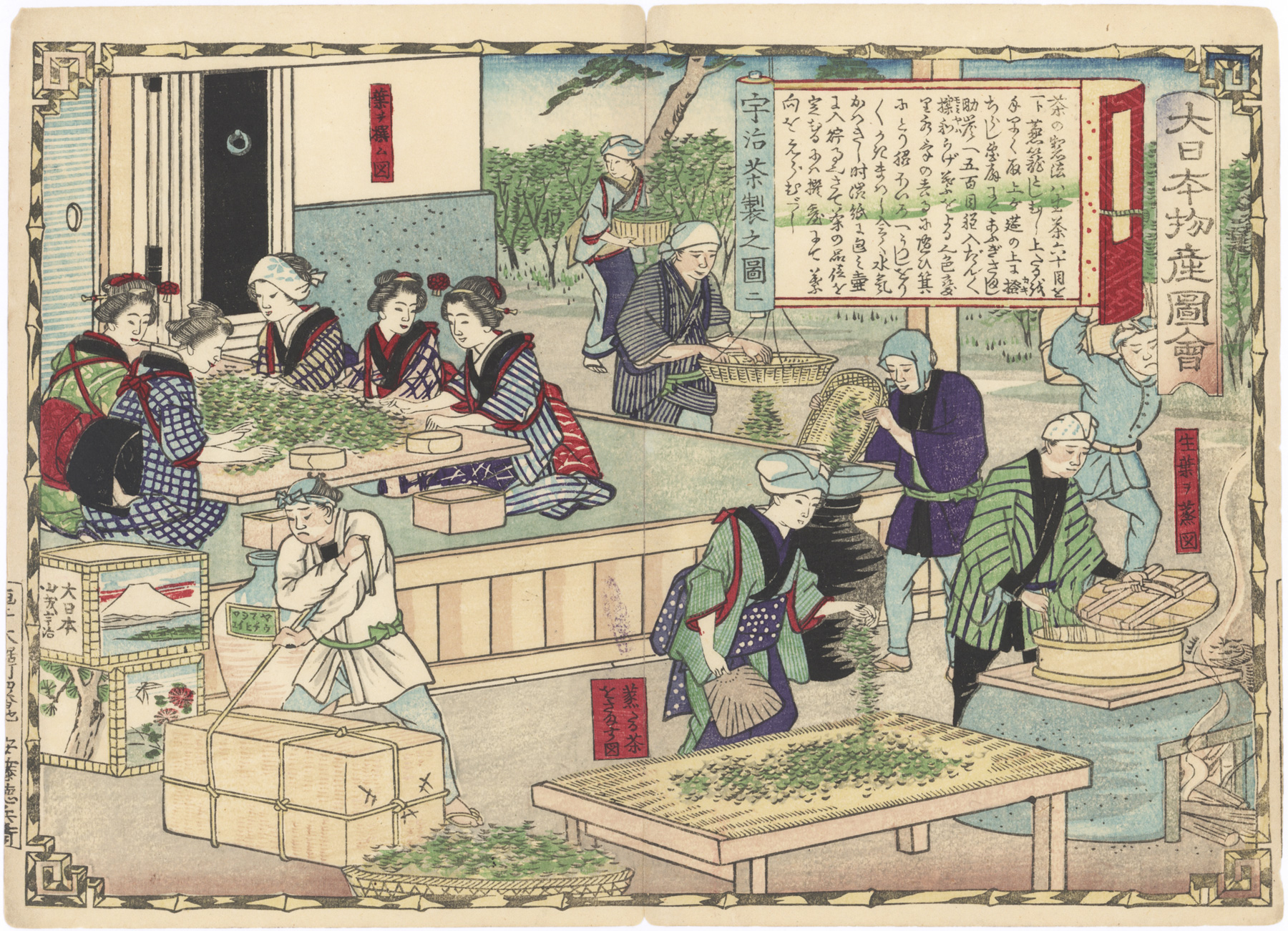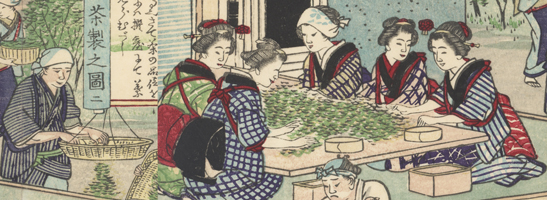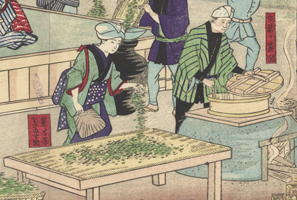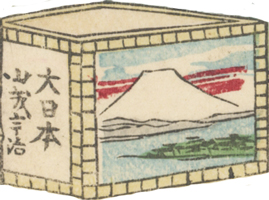About This Print
One of 118 prints in the series Dai Nippon Bussan Zue (Products of Greater Japan), issued in August 1877 to coincide with the opening of Japan’s first National Industrial Exposition (Naikoku Kangyō Hakurankai) held in Tokyo’s Ueno Park, depicting women and men sorting, sifting, steaming, drying, and packaging tea in Uji in Yamashiro Province. The Uji district was famed for its tea plantations and its high-quality tea which was unequaled in Japan. Historically, "the Uji powdered-tea industry was so important that it received bakufu protection, and farmers had to sell their tea through designated channels."1Uji farmers excelled "in the processing of green tea,especially as a result of innovations developed in the 1730’s. Instead of kettle-firing, they steamed theleaves and then rolled rubbed them over a hearth. This process produced a flavorful tea highlyprized in central markets."2
This superior tea "became especially importantwith the opening of the ports in 1859, when tea became one of the country’sleading export items. From 1859 to 1867tea exports increased over eighteen-fold,with more than 7 million pounds beingexported in 1867 alone."3
The German Professor of Geography and East Asia traveler, Johannes Justus Rein, described both the sorting and steaming process seen in the print in his 1899 book The Industries of Japan, as follows:4
Sifting and Sorting the Tea [To sift the tea] a sieve is suspended breast-high by a rope from the ceiling, so that it can be moved with ease in every direction, as well as in a circle. The finer stuff falls through on a pile, and there remain the more equally rolled and twisted leaves. Lastly, this tea, designed for exportation, is spread out on a table and carefully gone over again by girls, who pick out all remaining impurities…
Multiple Editions (Variant Printings)
At least three variant printings (editions) were made of this series. Each variant printing uses a different colored cartouche containing the series' name, either red, green or rainbow-colored. [In addition, a blue cartouche occasionally appeared.] Different colored borders were also used and variances in the use of colors and shading are present in the three editions.Transcription of Scroll
5 Wikipedia https://en.wikipedia.org/wiki/Yamashiro_Province
Print Details
| IHL Catalog | #1481 |
| Title or Description | Producing Uji Tea in Yamashiro Province, figure 2 山城国宇治茶製之図 二 Yamashiro no kuni Uji cha sei no zu ni |
| Series | Dai Nippon Bussan Zue 大日本物産図会 (Products of Greater Japan) |
| Artist | Utagawa Hiroshige III (1842–1894) |
| Signature |  |
| Seal | none |
| Publication Date | 1877 (Meiji 10) |
| Publisher | Ōkura Magobei 大倉孫兵衛 (Kin'eido; 1843-1921) [Marks: pub. ref. 627] appearing in right margin (trimmed from this print) Full cartouche reads 出版人 日本橋通一丁目十九番地 大倉孫兵衛 (Publisher, Nihobashi-dōri Itchōme 19-banchi, Ōkura Magobei) |
| Impression | good |
| Colors | excellent |
| Condition | good - vertical centerfold with some paper separation reinforced by tape on verso; small loss to margin corners |
| Genre | nishiki-e; kaika-e |
| Miscellaneous | |
| Format | chuban |
| H x W Paper | 6 13/16 x 9 5/16 in. (17.3 x 23.7 cm) |
| H x W Image | 6 3/8 x 9 1/8 in. (16.2 x 23.2 cm) |
| Literature | |
| Collections This Print | Waseda University Library Archives 01_04265_0001 |

![Digging Kudzu [Pueraria] Root in Yamato Province from the series Dai Nippon Bussan Zue (Products of Greater Japan)](https://sites.google.com/a/myjapanesehanga.com/www/_/rsrc/1290411621528/home/artists/hideo-hagiwara-1913---2007-/germination-2/Next-print-rev1-30x30.jpg)



